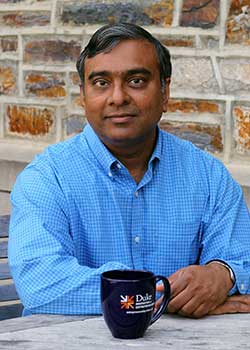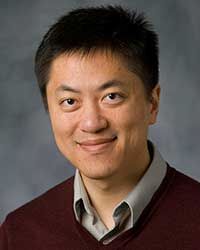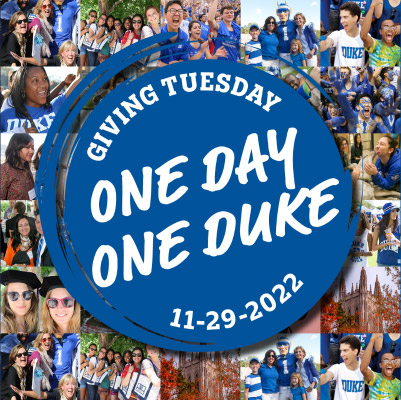Computational Thinking is for Everyone
Computational Thinking is for Everyone
Duke's Center for Computational Thinking enables computational education throughout the university.

- Benjamin Asomani
As a first-year Duke student working towards a career in medicine, Benjamin Asomani was curious about computer science and coding, but wary of diving into coursework without prior exposure to the field. At the suggestion of another student, he participated in the summer 2021 Code+ program, learning CSS and HTML skills as part of an applied group project, while confirming his interest in computer science. This semester, Asomani has begun coursework for a minor in computer science to complement his planned major in biology.
“The hands-on learning was a good way to be introduced to coding. I liked the process of making and building something for a project and having instructors who could help us review our work and spot mistakes,” said Asomani, who finished the program feeling confident about his abilities in CSS and HTML.
Duke's Center for Computational Thinking (CCT) launched in 2020 to support and coordinate campus-wide resources for faculty, students and staff. Its core priority is to ensure all Duke students can be exposed to computational approaches and learn to use data to create new knowledge.
For students like Asomani, the CCT's network of programs can provide an introduction to computing, and make computational majors more accessible by reducing real or perceived barriers to entry.

- Harsha Srijay
For undergraduate Harsha Srijay, the summer 2020 +DataScience Advanced Research Program linked his math and data science majors with his interest in bioinformatics for a project exploring the use of predictive models for diagnosing respiratory diseases. “I'm more interested in applied work than theoretical modeling, and this project let me focus on using the tools of data science to solve real-world problems,” Srijay noted.
To support instruction, the CCT works with faculty and departments across Duke to integrate computing-related content into their courses, and provides learning modules to supplement faculty instruction.

- Sally Kornbluth
“Learning how to draw critical conclusions from data and to take computational approaches to solving complex problems across disciplines are important elements of a 21st century liberal arts education,” said Provost Sally Kornbluth. “The CCT is connecting existing resources at Duke — and responding to gaps in our current offerings — to ensure all students and faculty have the opportunity to bring these approaches to their studies and their research.”

- Matthew Hirschey
Kornbluth recently appointed Duke School of Medicine Professor Matthew Hirschey to lead the center, working in close partnership with computing colleagues across campus. A molecular physiologist who embraced data science several years ago to advance his own skills and his lab's data analysis capabilities, Hirschey is committed to helping students and colleagues realize the benefits of computational approaches.
“As someone who came to computation rather recently, my perspective is that this is something everyone should know,” Hirschey said. His vision involves helping students who are already steeped in computing understand its intersections with ethics, policy and other fields. And for liberal arts students and scholars, Hirschey wants the CCT to help them become “comfortable and capable with computation and computational tools to extract meaning from data, regardless of their field of study,” he noted. “Because the current generation of liberal arts students should understand how computational approaches can be used to find patterns in literature, or art, or dance.”

- Jessica Portillo
In a mini-course on data science led by Hirschey, Ph.D. students Taylor Chavez and Jessica Portillo learned computational skills with immediate application to their research. “I come from a wet lab background, and this has provided the foundation and basic components of what I need, and clarified that I do want to do more computational work in the future,” said Portillo.

- Taylor Chavez
Chavez studies tissue engineering and used course assignments to work with data from her experiments. “I have some coding background, but really not enough,” she said. “This was the first time I’d actually taken a class that was meant to teach me how to analyze and visualize experimental data in the context of my science. I brought my own data, and I got to play with different ways to visualize the results in ways that made sense for how I wanted to present my data.”
What is computational thinking?
The term “computational thinking” may evoke associations with artificial intelligence and machine learning, which describe processes carried out by computers. But computational thinking is a human skill and process for approaching large problems.

- Krishnendu Chakrabarty
“Basically, what computational thinking means is breaking down the big problem into smaller pieces. That’s how computers operate. That’s how we solve computational problems; we don’t look at one huge problem and try to solve that by itself, we break it down into smaller pieces, and then we solve the new pieces, then we have to find a way to link them. All of that is not trivial, not obvious. But we need to have the knowledge and the thinking so that we can connect the dots and link these smaller problems together to solve a big problem.”
—Krish Chakrabarty, chair, Department of Electrical and Computer Engineering
The Power of Collaboration
As a “virtual” center, without a dedicated physical space or extensive administrative staff, the CCT is the product of intentional collaboration among computing leaders at Duke, with affiliated faculty, advisors and sponsors representing multiple areas of the university.
For Jun Yang, chair of Duke's computer science department, the CCT is an important element of the department's response to substantial growth in student interest in the field, as well as an increasingly diverse body of students pursuing computer science.
“Ten years ago, we had a less diverse student body in computer science in terms of experience and preparation,” Yang said. “Now we have students coming in with very different backgrounds and interests, so we have to figure out ways to redesign our curriculum to create personalized pathways, and help people fill in gaps in their knowledge where needed. We're working with the CCT to create modules that can be put together in an agile fashion to help students have a more consistent experience across the board.”
Krish Chakrabarty, chair of Duke's electrical and computer engineering (ECE) department, notes that computing is the common enabler of advances in AI- and machine learning-supported fields including quantum science, materials science and computer engineering. As his department considers new courses, design experiences and student projects, “CCT can provide learning modules and tutorials to help faculty adapt to material that is dynamic and changing rapidly.”

- Jun Yang
Chakrabarty and Yang say the benefits of a joint effort like CCT extend far beyond their own departments. Chakrabarty notes that across STEM disciplines, there is a need for a concerted effort like CCT to help prioritize how and what students learn related to computing. “Without the structure, computing tends to get a less visible role and a lower priority in the hierarchy of learning,” he said.
Yang is enthusiastic about the potential for the CCT to help Duke students become leaders who can use computational thinking to advance scientific discovery, public policy, law, medicine and other fields. “Duke has a unique position and a unique role in terms of integrating computational thinking with a variety of other disciplines that really make a difference. It’s not just to prepare our students to survive in this new world, but to help them to lead,” he said.

- Tracy Futhey
Duke's Chief Information Officer, Tracy Futhey, is also a champion of the CCT and its role in supporting computing education throughout the university. She notes that the center is already knitting together and helping students navigate Duke's many academic and co-curricular computing opportunities, as well as making new connections among faculty involved in existing programs. Futhey also envisions the CCT playing a strong role as a partner to faculty from all disciplines “for academic programs that have not previously considered how data analytics or computational components might be used in teaching within their discipline, the CCT is a resource to help faculty explore how computational approaches could be incorporated.”
